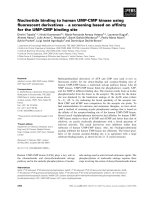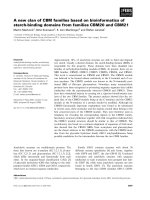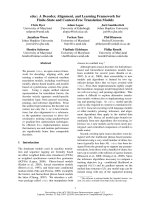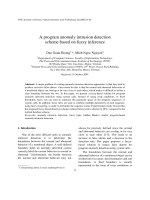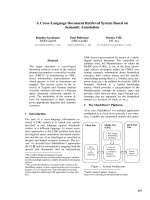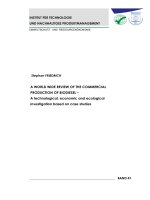Developing a tailor it service management framework based on ITIL framework for it service management processes in ethiopian commercial banks
Bạn đang xem bản rút gọn của tài liệu. Xem và tải ngay bản đầy đủ của tài liệu tại đây (1.29 MB, 118 trang )
ADDIS ABABA UNIVERSITY
COLLEGE OF NATURAL AND COMPUTATIONAL SCIENCE
SCHOOL OF INFORMATION SCIENCE
DEVELOPING A TAILOR IT SERVICE MANAGEMENT
FRAMEWORK BASED ON ITIL FRAMEWORK FOR IT SERVICE
MANAGEMENT PROCESSES IN ETHIOPIAN COMMERCIAL
BANKS: THE CASE OF BUNNA INTERNATIONAL BANK S.C.
By
TADESSE DABI
June, 2017
ADDIS ABABA, ETHIOPIA
ADDIS ABABA UNIVERSITY
COLLEGE OF NATURAL AND COMPUTATIONAL SCIENCE
SCHOOL OF INFORMATION SCIENCE
DEVELOPING A TAILOR IT SERVICE MANAGEMENT
FRAMEWORK BASED ON ITIL FRAMEWORK FOR IT SERVICE
MANAGEMENT PROCESSES IN ETHIOPIAN COMMERCIAL
BANKS: THE CASE OF BUNNA INTERNATIONAL BANK S.C.
A Thesis Submitted to School of Graduate Studies of Addis Ababa University in
Partial Fulfillment of the Requirements for the Degree of
Master of Science in Information Science
By: Tadesse Dabi
Advisor: Lemma Lessa (PhD)
June, 2017
Addis Ababa, Ethiopia
ADDIS ABABA UNIVERSITY
COLLEGE OF NATURAL AND COMPUTATIONAL SCIENCE
SCHOOL OF INFORMATION SCIENCE
DEVELOPING A TAILOR IT SERVICE MANAGEMENT
FRAMEWORK BASED ON ITIL FRAMEWORK FOR IT
SERVICE MANAGEMENT PROCESSES IN ETHIOPIAN
COMMERCIAL BANKS: THE CASE OF BUNNA
INTERNATIONAL BANK S.C.
By: Tadesse Dabi
Name and signature of Members of the Examining Board
Lemma Lessa (PhD)
__________
_________
Advisor
Signature
Date
Gashaw Kebede (PhD)
__________
_________
Internal Examiner
Signature
Date
Tibebe Beshah (PhD)
__________
_________
Internal Examiner
Signature
Date
Declaration
This thesis has not previously been accepted in substance for any degree and is not being
concurrently submitted in candidature for any degree in any university.
This thesis is the result of my own investigations, except where otherwise stated. Other sources
are acknowledged by citations giving explicit references. A list of references is appended.
Signature: ________________________
Tadesse Dabi
This thesis has been submitted for examination with my approval as university advisor.
Advisor’s Signature: ________________________
Lemma Lessa (PhD)
i
Acknowledgements
First of all, I would like to forward my deepest thanks to the almighty God. I am also deeply
grateful to my advisor Dr. Lemma Lessa for his precious remarks, constructive comments and
suggestions during the course of this study. In addition to his contribution to this thesis, I also
like to thank his thoughtful contributions to my run-of-the-mill of knowledge.
My special thanks go to my wife, Beleteshachew Seifu, and my sons, Naol, Firaol and Naome.
Their love, encouragement, and support carry me lengthways. I wouldn’t have finished this
thesis without their support and love.
Furthermore, I would like to express my deep gratitude to all IT staffs and managements of
Bunna International Bank who participated in this study during the data collection process as
well as Lion International Bank IT staffs who contributed innovative idea for the development
and improvement of data collection instruments.
Finally, I would like to thank everyone at the College of Natural and Computational Science,
School of Information Science, AAU, who has encouraged and assisted me throughout the
completion of this thesis.
ii
Abstract
In today’s complex IT environment, the global economy is increasingly service-based. As a
result, IT Service providers have a growing need for developing IT Service Management (ITSM)
Framework based on best practices. The Information Technology Infrastructure Library (ITIL) is
a set of best practices and widely implemented ITSM framework in the world. However, ITIL is
not a one-size-fits-all solution; rather IT organizations are required to adopt ITIL in different
ways possibly due to cultural, political or economic factors. Research in ITIL adoption is in its
infant stage. The status of ITIL adoption has become one of the most popular research topics in
ITSM research. Thus, this research aims to develop ITSM Framework based on ITIL Framework
for Ethiopian Banking Industry.
For this purpose, a case study research strategy was applied as empirical research approach to
closely examine the data within a specific context and to analyze different qualitative elements of
ITSM practices and ITIL guidelines. Primary and secondary data were collected using
questionnaire and semi-structured interview through review of company documents. Data was
then analyzed and interpreted under guidance of ISO 15054 Process Assessment Model and
SWOT analysis techniques.
The results indicated that out of the twenty four ITIL V3 processes in scope, twenty two did not
fully or largely achieve their intended purpose in the case study organization; hence irregular or
inconsistent ITSM process performance may be introduced. Therefore, tailored ITSM
Framework is proposed based on the current operational model, assessment findings and the
SWOT analysis. In the proposed Framework, components’ activities and processes relationship
are discussed based on ITIL concepts. The proposed Framework can help the Ethiopian Banking
Industry to effectively manage IT services design, development, deployment, delivery and support
processes. Besides, who and when to use the proposed Framework is also suggested.
Keywords: IT Service Management, ITIL, Service Management Processes
iii
Table of Contents
Abstract .................................................................................................................................... iii
List of Tables ........................................................................................................................... vii
List of Figures ......................................................................................................................... viii
List of Appendices .................................................................................................................... ix
List of Acronyms ........................................................................................................................x
CHAPTER ONE .........................................................................................................................1
INTRODUCTION ......................................................................................................................1
1.1 Background .......................................................................................................................1
1.2 Statement of the Problem ...................................................................................................2
1.3 General Objective of the Study ..........................................................................................4
1.4 Specific Objectives of the Study ........................................................................................4
1.5 Significance of the Study ...................................................................................................4
1.6 Scope of the Study .............................................................................................................5
1.7 Organization of the Thesis .................................................................................................5
CHAPTER TWO ........................................................................................................................7
LITERATURE REVIEW ............................................................................................................7
2.1 IT Governance ...................................................................................................................7
2.1.1 IT Governance Trends .................................................................................................8
2.1.2 Core Focus Areas of IT Governance .......................................................................... 10
2.2 Information Technology Services .................................................................................... 12
2.3 Information Technology Service Management (ITSM) .................................................... 14
2.4 IT Service Management and its Organizational Impact .................................................... 16
2.5 IT Governance versus IT Management............................................................................. 17
2.6 IT Governance frameworks .............................................................................................. 17
2.6.1 COBIT ...................................................................................................................... 18
2.6.2 ISO/IEC 20000.......................................................................................................... 18
2.6.3 ISO/IEC 15504.......................................................................................................... 19
2.6.4 ISO/IEC 19770:2006 ................................................................................................. 19
iv
2.6.5 Management of Risk ................................................................................................. 20
2.6.6 Project management Body of Knowledge .................................................................. 20
2.6.7 CMMI ....................................................................................................................... 20
2.6.8 Six Sigma .................................................................................................................. 21
2.6.9 ITIL .......................................................................................................................... 21
2.7 Previous Researches ........................................................................................................ 30
2.8 Chapter Summary ............................................................................................................ 31
CHAPTER THREE................................................................................................................... 33
RESEARCH DESIGN AND METHODOLOGY ...................................................................... 33
3.1 Research Approach .......................................................................................................... 33
3.2 Research Method ............................................................................................................. 34
3.3 Research Design .............................................................................................................. 35
3.4 Sampling Method ............................................................................................................ 36
3.5 Data collection Method .................................................................................................... 36
3.5.1 Primary Data ............................................................................................................. 37
3.5.2 Secondary Data ......................................................................................................... 38
3.6 Data Analysis Procedure .................................................................................................. 38
3.7 Quality of the Research Design ........................................................................................ 40
3.8 Confidentiality Agreement ............................................................................................... 41
3.9 Assessment Constraints.................................................................................................... 41
3.10 Chapter Summary .......................................................................................................... 41
CHAPTER FOUR ..................................................................................................................... 42
RESULT AND DISCUSSION .................................................................................................. 42
4.1 Coverage of assessment and Profile of Interviewees ........................................................ 42
4.2 Result .............................................................................................................................. 42
4.2.1 Core IT Services ........................................................................................................ 45
4.2.2 The Current Operation Model .................................................................................... 46
4.2.3 SWOT Analysis ........................................................................................................ 49
4.3 Discussion ....................................................................................................................... 54
4.3.1 Service Strategy Life Cycle ....................................................................................... 54
4.3.2 Service Design Life Cycle ......................................................................................... 55
v
4.3.3 Service Transition Life Cycle .................................................................................... 55
4.3.4 Service Operation Life Cycle..................................................................................... 56
4.3.5 Continual Service Improvement Life Cycle ............................................................... 57
4.5 The Proposed Tailored ITSM Framework ........................................................................ 59
4.6 Components and Processes of the Proposed Framework .................................................. 62
4.6.1 IT-Business Alignment Component ........................................................................... 62
4.6.2 IT Service Design & Development Component ......................................................... 62
4.6.3 Service Transition & Support Component ................................................................. 63
4.6.4 IT Service Operation & Performance Management .................................................... 64
4.6.5 Service Improvement Plan Component ...................................................................... 65
4.7 Who and When to use the proposed ITSM Framework .................................................... 67
4.8 Chapter Summary ............................................................................................................ 67
CHAPTER FIVE ...................................................................................................................... 69
CONCLUSION AND RECOMMENDATIONS ....................................................................... 69
5.1 Conclusion....................................................................................................................... 69
5.2 Limitations of the Study................................................................................................... 69
5.3 Recommendation ............................................................................................................. 70
5.3.1 Recommendation for Practitioners ............................................................................. 70
5.3.2 Recommendation for Future Research ....................................................................... 71
REFERENCES ......................................................................................................................... 72
vi
List of Tables
Table 1-1: Structure of the thesis .................................................................................................6
Table 2-1: ITIL V2, V3 and V3-2011 processes and functions (source: OGC) ........................... 24
Table 2-2: Summary of benefits of ITIL (Marrone and Kolbe 2010) .......................................... 30
Table 4-2: Categories of User Request and Support Matrix ....................................................... 49
Table 4-1: Consolidated Questionnaire Result .......................................................................... 53
vii
List of Figures
Figure 2-1: Evolution of the IT Function within organizations ....................................................9
Figure 2-2: Relationships between the Four IT Service Categories ........................................... 13
Figure 2-3: ITSM components ................................................................................................... 16
Figure 2-4: ITIL V2 Framework ................................................................................................ 25
Figure 3-1: Process of the Research.......................................................................................... 34
Figure 4-1: Information Systems Directorate Structure ............................................................. 44
Figure 4-2: Information Systems Directorate Core IT Services ................................................. 45
Figure 4-3: The current operation model .................................................................................. 48
Figure 4-4: Tailored ITSM Framework Proposed to BIB .......................................................... 61
viii
List of Appendices
Appendix A: Preliminary Survey Questionnaire .......................................................................... i
Appendix B: Pilot Test Questionnaire........................................................................................ iii
Appendix C: Questionnaire and Detail Response ....................................................................... xi
Appendix D: Interview Guide .................................................................................................. xvii
Appendix E: Interview Response ................................................................................................. i
ix
List of Acronyms
BIB
Bunna International Bank
CCTA
Central Computer and Telecommunications Agency
CMMI
Capability Maturity Model Integrated
COBIT
Control Objective for Information Technology
ISO/IEC
International Organization for Standardization/International
Electrotechnical Commission
IT
Information Technology
ITG
IT Governance
ITGI
IT Governance Institute
ITIL
Information Technology Infrastructure Library
ITSM
Information Technology Service Management
itSMF
The IT Service Management Forum
OGC
Office of Government Commerce
SEI
Software Engineering Institute
SWOT
Strengths, Weaknesses, Opportunities, and Threats
x
CHAPTER ONE
INTRODUCTION
The main purpose of this chapter is to introduce the background of ITIL adoption and
development; describe the problem and to have an overall view on the study. The chapter also
raises the main research questions of this thesis and a brief overview of the existing research
achievements related to tailor ITSM Framework based on ITIL Framework in organizations and
finally how this thesis conducted.
1.1 Background
IT is undergoing a rapid transformation in the banking industry. No longer independent, IT must
play an increasingly greater role in helping banks carry out their business operation such as
marketing, sales, and channel integration initiatives, and in ensuring that banks comply with
various regulatory requirements. To this end, IT in banking sector needs to develop a strategic
approach to service management processes. In short, IT in banking is expected to deliver
compliance, consistency, continuity and security while changing the way banking is done.
ITSM is a branch of the field of Information Systems Maintenance (ISM); and ISM focuses on
technique and delivery of goods while ITSM is a newly emerging field focusing on processes
and services (Marrone & Kolbe 2011). Iden & Langeland (2010) stated that various frameworks
for ITSM exist, among which Information Technology infrastructure library (ITIL) is most
accepted and used; further Pollard & Cater-Steel (2009) indicated one of the ITSM framework
that becomes particularly prominent is the ITIL. Jäntti et al. (2013) also pointed that thousands of
IT organizations worldwide have started to improve their IT service management processes
based on the ITIL, which is the most widely used best practice framework for IT service
management (ITSM); however a major challenge has been how the people responsible for
process improvement can demonstrate the benefits that process improvement initiatives provide.
Iden & Eikebrokk (2013, p. 2) explained the relationship between ITSM and ITIL as “ITSM is
the concept and ITIL is the framework IT functions can apply to adopt ITSM to IT operations”.
Iden and Eikebrokk (2013, p. 6) also further indicated that the earliest academic study on ITIL
adoption, as identified by a 2013 systematic literature review was a conference article published
1
in 2005 and the first journal article was published in 2006. After these, the status of ITIL
adoption has become one of the most popular research topics in ITSM research.
Marrone, et al, (2014) has also identified benefits from ITIL adoption such as improved focus on
ITSM, more rigorous control of testing and system changes, more predictable infrastructure,
improved consultation with IT groups within the organization, smoother negotiation of service
level agreements, reduced server faults, seamless end-to-end service, documented and consistent
IT processes across the organization. Iden & Langeland (2010, p. 104) also supported the idea
too and emphasized despite the fact that ITIL is increasingly adopted in public and private
companies there are few scholarly works that examine issues related to its introduction. Meziani
& Saleh (2010) discovered that any organizations developed its own ITSM model in order to
increase the service level, reduce cost and improve security such as: Microsoft and HP, Procter
& Gamble, Caterpillar, State Farm and Boeing in the USA. Organization have incorporated
aspects of ITIL and IT Service Management into their IT Management strategies. These all
reflect ITIL adoption effort is at its early stage; and justify as why developing tailor ITSM
Framework based on ITIL framework for ITSM processes in Ethiopian Commercial Banks is
selected as focus of this research.
Bunna International Bank S.C. is one of commercial Banks in Ethiopia which has joined the
Banking industry of Ethiopia following the favorable economic developments witnessed in the
country during the last decade and the incessantly growing needs for Financial Services. The
Bank has obtained its license from the National Bank of Ethiopia (NBE) on June 25, 2009 in
accordance with Licensing & Supervision of Banking Business Proclamation No. 592/2008 and
the 1960’s Commercial Code of Ethiopia. The bank officially commenced its operation on
October 10, 2009 with the subscribed and paid up capital of birr 308 million and birr 156
million, respectively. Now the paid up capital of the bank has grown up to 757 million as of
August 16, 2016. Currently, the bank has 107 branches that are found both in Addis Ababa and
other towns of Ethiopia (About BIB Background, Published: Thursday, 18 August 2016 15:15).
1.2 Statement of the Problem
Marrone et al., (2014) found that ITIL is considered a “best practice”, its adoption may not be
homogeneous across all IT organizations. IT organizations adopt ITIL in different ways possibly
due to cultural, political or economic factors. Regardless of country, size, or industry sector,
2
many organizations have not fully adopted the ITIL framework. Consequently there are
opportunities for organizations to gain performance rewards associated with ITIL adoption, such
as more rigorous control of testing and system changes, more predictable infrastructure,
improved consultation within the organization, smoother negotiation of SLAs, reduced server
faults, seamless end-to-end service, consistent IT processes, and effective change management.
Cater-Steel & Wui-Gee (2005, p. 1) noted that despite the phenomenal popularity of ITIL as
reported in IT practitioner magazines, there has been little academic research published to date
about issues related to ITIL adoption and implementation. Alan & Robert (2016) and Bridget
(n.d.) explained that many organizations turn to IT infrastructure libraries (ITIL) to better
manage how IT services and technology are delivered to users, but ITIL is not a one-size-fits-all
solution; the specific needs and even the size of the environment are driving factors. In some
cases, we might need to customize and/or adopt ITIL to the needs of the organization or we
might not need ITIL at all. Hjalmarsson, et al. (2016, p. 1) indicated that the domain of ITSM
covers several frameworks, models or methods aimed to support efficient ITSM work in
organizations. One of the most well-known ITSM-frameworks is the Information Technology
Infrastructure Library
The study made by the Ethiopia Ministry of Communication and Information Technology (2011)
indicated that, there was lack of a holistic coordination and cooperation across the Government
for properly developing and utilizing IT. Besides it identified that, the IT organization structures,
roles, and responsibilities are not properly defined nor approved and there was lack of a clear
program and project management framework and tools for IT development.
According to the preliminary survey conducted on assessing ITSM Practices in Ethiopian
Banking Industry, ITIL adoption is gaining momentum but is still in the early stages of
implementation for most Ethiopia Banking Industries. Adoption of the ITIL framework
(guidelines, principles, and concepts) is either absent or is still being established and is not yet
fully implemented. Bunna International Bank is one of the Ethiopian Commercial Banking
Services which has not yet implemented ITIL framework based on its response to preliminary
survey questionnaire of assessing ITSM processes of the organization (Appendix - A). So, that is
why this study focused on developing tailored ITSM Framework based on ITIL best practices for
Bunna International Bank S.C. ITSM processes.
3
Thus, the goal of this study was to characterize the existing trends and desired states of ITSM
processes of the case study organization; and then to propose tailored ITSM processes in the
Ethiopian context based on ITIL best practices. The motivation for this study was the desire to
learn challenges or difficulties from current trends of ITSM processes, and develop tailored
ITSM Framework based on ITIL best practices successfully by giving due attention to the
desired state too.
The main purpose of the study was to identify ITSM practices and develop tailored ITSM
Framework based on ITIL best practices for Bunna International Bank ITSM processes. For this
purpose, the researcher has formulated the following main research questions:
What are the current and desired states of ITSM processes in Bunna International Bank?
How can one develop tailored ITSM Framework based on ITIL best practices?
1.3 General Objective of the Study
The main purpose of this study was to identify current ITSM practices of Bunna International
Bank and develop tailored ITSM Framework based on ITIL best practices by address
shortcoming of the existing practice.
1.4 Specific Objectives of the Study
To review related literature and overview different IT Governance frameworks
To identify and document the current and desired states of ITSM processes of the
organization
To deliver tailored ITSM framework for ITSM processes of Bunna International Bank.
1.5 Significance of the Study
This study will be a significant endeavor in promoting best practices of ITSM processes for
Bunna International Bank. This study will also be beneficial to the Ethiopian Banking Industries
to review their ITSM practices and develop tailored ITSM Framework based on ITIL framework
by understanding the needs and benefits of ITIL best practices. By detailing and comparing the
ITIL adoption, this research helps bridge the gap between practitioner and academic research and
provides valuable insights to both communities. Moreover, the result of this study can be used as
an input for future studies on related topics.
4
1.6 Scope of the Study
The scope of the study enclosed to investigate and analyze the current and desired state of ITSM
processes of Bunna International Bank S.C to develop tailored ITSM Framework based on
ITILv3 Framework to address shortcoming of the existing practice and challenges if any. The
study only delimited ITSM processes, not in the technology for implementing it. The focus of the
study is to develop tailored ITSM Framework based on ITILv3 Framework for the organization
processes which considered as the latest version of ITIL framework. The ITSM process owners
have been active participants of the study and also information from the management team of
Information Systems Directorate of the organization was useful to enrich the data. The ultimate
goal was to develop tailored ITSM Framework based on ITIL best practices for the case study
organization’s IT department.
Consequently, this thesis research began with a literature review on IT Governance, IT Services,
IT Service Management, IT Governance Frameworks and ITIL. These were followed by a
description of the methodology used for this research. Results of the survey analyzed to develop
ITIL framework and then outcomes discussed. Finally, after the limitations of the study the
conclusions and future research sections are drawn.
1.7 Organization of the Thesis
The thesis organized into five chapters. The following Table 1-1 has shown how the thesis was
prearranged.
Chapters Contents and organizations
Chapter
In the first chapter, the arrangement of the thesis is discussed. Some issues like the
One
background of the research, statement of the problem, purpose of the study,
research questions, significance and scope of the study are provided.
Chapter
The second chapter reviewed the related literature on IT Governance, IT services,
Two
ITSM and ITIL framework.
Chapter
The third chapter discussed methodologies which researcher applied to his research
Three
study. In this section the research approach, the research design, data collection
and analysis procedures and techniques as well as strategies for validating the thesis
along with the reliability of the research are presented.
5
Chapters Contents and organizations
Chapter
In the fourth chapter, results and the relationship of the result with reviewed
Four
literatures were discussed. In this chapter the proposed Framework also presented
and discussed. Besides, the limitation of the study is set.
Chapter
In the final chapter, the conclusion of the study is provided by the researcher.
Five
Moreover, in this part the researcher evaluates the research and presents ideas for
developing the concept for practitioner and future research.
Table 1-1: Structure of the thesis
6
CHAPTER TWO
LITERATURE REVIEW
Conducting a literature review is essential to any program of research as it provides an
assimilation of extant literature, assists in positioning and scoping the research, and builds
knowledge (Paul & Jeanne, 2009). The purpose of the literature review is to understand
concepts, theories, and current knowledge on IT Governance and ITSM processes in general and
ITIL Framework in particular including but not limited to the adoption of ITIL. This helped the
researcher to identify approaches to assess ITSM processes and adopt ITIL framework based on
the world experienced.
2.1 IT Governance
IT Governance (2005) stated that IT Governance is not just an IT issue or only of interest to the
IT function. In its broadest sense it is a part of the overall governance of an entity, but with a
specific focus on improving the management and control of Information Technology for the
benefit of the primary stakeholders.
IT Governance is not a one-time exercise or something achieved by a mandate or setting of rules.
It requires a commitment from the top of the organization to instill a better way of dealing with
the management and control of IT. IT Governance is an ongoing activity that requires a
continuous improvement mentality and responsiveness to the fast changing IT environment
(ITG, 2005, p. 8).
IT Governance Institute (2008) revealed that they have been working to define IT governance for
a number of years and the definition has changed over time. Its origins were in control and
measurement but it has moved and progressed into more front-end planning, putting the
processes in place. It is more preventive, rather than taking action afterwards. It is the framework
to do business, make decisions and monitor progress. This means that the IT governance is very
important to the enterprise and important way to improve business and to achieve enterprise
objectives.
According to the IT Governance Institute (2007), the IT governance is a management process
based on best practices allowing the company directing the IT functions in the goal to support its
7
objectives of creating value, improve the performance of IT processes, master the financial
aspects of IT, develop IT solutions and skills that the company will need in the future and ensure
that the IT risks are managed while developing transparency
Chekli & Namir (2015, p. 1) stated IT governance as “an integral part of enterprise governance
and consists of the leadership and organizational structures and processes that ensure that the
organization's IT sustains and extends the organization's strategies and objectives”. Van & De
(2009) described Information Technology Governance (ITG) as the specification of decisionmaking structures, processes, and relational mechanisms for guidance and control.
From the definitions stated above it could be understood and identified that ITG is an
organizational skill of great importance for alignment and organizational value achievement
through information technology.
2.1.1 IT Governance Trends
The IT Governance Institute (ITGI) was established in 1998 to advance international thinking
and standards in directing and controlling an enterprise’s information technology.
The need for strong IT governance has been recognized since the advent of IT itself. Methods
and frameworks to support this have existed for decades. According to Mathias Sallé (2004, p.2),
when evolving from technology providers into strategic partners; IT organizations typically
follow a three-stage approach as depicted in Figure 2-1. Each evolutionary stage builds upon the
others beginning with IT infrastructure management (ITIM). During this stage, the IT
organizations focus on improving the management of the enterprise infrastructure. Effective
infrastructure management means maximizing return on computing assets and taking control of
the infrastructure, the devices it contains and the data it generates. The next stage, IT service
management (ITSM), views the IT organizations actively identifying the services its customers
need and focusing on planning and delivering those services to meet availability, performance,
and security requirements. In addition, IT is managing service-level agreements, both internally
and externally, to meet agreed-upon quality and cost targets. Ultimately, when IT organizations
evolve to IT business value management (IT Governance), they are transformed into true
business partners enabling new business opportunities. In that stage, IT processes are fully
8
integrated with the complete lifecycle of business processes improving service quality and
business agility.
Maturity of
IT Function
IT Governance
Strategic
Partner
Service
Provider
Technology
Provider
ITSM
ITIM
Time
Figure 2-1: Evolution of the IT Function within organizations, adopted from Mathias Sallé
(2004)
Information and communication technologies are now widely accepted by developing countries
like Ethiopia as a critical tool in their efforts to eradicate poverty and enhance human
development by the United Nations, through its UN Development Program which actively
promotes ICT4D (Information and Communications Technologies for Development) as a
powerful tool for economic and social development around the world. According to the study
made by the Ethiopia Ministry of Communication and Information Technology (2011, p. 39) to
prepare e-Government Strategy and Implementation Plan the following gaps were identified:
i.
Lack of a holistic coordination and cooperation across the Government for properly
developing and utilizing IT;
ii.
IT organization structures, roles, and responsibilities are not properly defined nor
approved, resulting in IT organizations in the Government Entity with varying levels of
maturity in terms of design and resourcing;
9
iii.
Lack of a clear program and project management framework and tools to ensure all eGovernment initiatives apply the same controls and quality measures and proper planning
is in place for IT development;
iv.
Lack of knowledge sharing and resources sharing which can speed the process of IT
implementations in common domains; and
v.
IT expenditure is not recognized among the Ministries/Agencies budget, in addition,
there is no allocation of a central fund to support central IT projects implementation.
Even though the assessment was based on the 13 Ministries and 11 Agencies, the Ministry of
Communication and Information Technology mission is to develop, deploy and use ICT to
improve the livelihood of Ethiopians and optimize its contribution for the development of the
country. The gap indicated at number ii and iii also motivated this thesis paper to assess ITSM
processes of the financial industry in Ethiopia and develop tailored ITSM framework.
2.1.2 Core Focus Areas of IT Governance
The IT governance concept has received considerable attention in the academic literature over
the last decade. Wilkin & Chenhall (2010) in a recent survey of IT governance, establish
taxonomy of IT governance. They see concepts of strategic alignment, performance
measurement, risk management, and value delivery as the most significant enablers of IT
governance. ITG (2005) stated IT Governance spans the culture, organization, policy and
practices that provide for IT management and control across five key areas:
2.1.2.1 Strategic Alignment
ITG (2005) stated that, “Strategic Alignment provides for strategic direction of IT and the
alignment of IT and the business with respect to services and projects”. Mathias (2004) indicated
Strategic alignment concerns all the characteristics of the IT Utility and thus must apply
holistically to the various management disciplines that will regulate the infrastructure. It also
suggested that strategic alignment can be achieved in a utility infrastructure by introducing the
discipline of management by objectives.
2.1.2.2 Value delivery
ITG (2005) described the Value delivery IT Governance domain to be used to confirm the
IT/Business organization is designed to drive maximum business value from IT. Oversee the
10
delivery of value by IT to the business, and assess Return on Investment. According to Mathias
(2004) value delivery is focused on the creation of business value and concentrating on
optimizing costs and proving the value of IT.
2.1.2.3 Performance management
According to ITG (2005), there is no doubt that a practical and effective way to measure IT
performance is an essential part of any IT Governance program, just as transparency and
reliability of financial results is a Corporate Governance necessity. Performance management is
important because it verifies the achievement of strategic IT objectives and provides for a review
of IT performance and the contribution of IT to the business (i.e. delivery of promised business
value). It is also important in providing a transparent assessment of IT’s capability and an early
warning system for risks and pitfalls that might otherwise have been missed. Performance
measurement provides transparency of IT related costs, which increasingly account for a very
significant proportion of most organizations’ operating expenses. As ITG points:
“If you can’t measure it, you can’t manage it” (ITG, 2005, p. 11)
Thus, performance measurement is a key component of IT Governance. It verifies the
achievement of strategic IT objectives and provides for a review of IT performance and the
contribution of IT to the business (i.e. delivery of promised business value).
2.1.2.4 Resource Management
According to ITG (2005) Resource Management IT Governance domain:
Provides high-level direction for sourcing and use of IT resources
Oversees the aggregate funding of IT at enterprise level and
Ensures there is an adequate IT capability and infrastructure to support current and
expected future business requirements.
Thus, Resource Management optimizing knowledge and IT infrastructure
2.1.3.5 Risk Management
ITG (2005) described the management of risks is a cornerstone of IT Governance, ensuring that
the strategic objectives of the business are not jeopardized by IT failures. IT related risks are
increasingly a Board level issue as the impact on the business of an IT failure, be it an
11
operational crash, security breach or a failed project, can have devastating consequences.
However, managing IT risks and exercising proper governance is a challenging experience for
business managers faced with technical complexity, a dependence on an increasing number of
service providers, and limited reliable risk monitoring information. As a consequence,
management is often concerned whether risks are being cost effectively addressed, and they need
assurance that risks are under control.
In summary IT Governance is concerned about IT delivers value to the business and that IT risks
are mitigated. This leads to the above main focus areas of the IT Governance, all driven by
stakeholder value. Two of them are outcomes: value delivery and risk mitigation. Two of them
are drivers: strategic alignment and performance measurements, as noted by Van (2004).
2.2 Information Technology Services
Software Engineering Institute (2010) defined a service as “service is a way of delivering value
to customers, while facilitating the achievement of the results they want to obtain without having
to deal with unnecessary and risky costs”.
Based on this definition of service, Diirr & Santos (2014, p. 1) defined Information Technology
(IT) service as a set of resources, whether IT or non-IT, perceived by the client as whole, and
maintained by an IT service provider. Such services aim to satisfy one or more needs of a client
and support the strategic goals of his business.
For the purpose of this study the definition given by Office of Government Commerce (OGC)
was used for services and IT Services, as it owns the ITIL brand (copyright and trademark).
OGC (2007, p. 5) stated that:
A service is a means of delivering value to customers by facilitating outcomes
customers want to achieve without the ownership of specific costs and risk. A
Service provided to one or more Customers by an IT Service Provider. An IT
Service is based on the use of Information Technology and supports the
Customer's Business Processes. An IT Service is made up from a combination of
people, Processes and technology and should be defined in a Service Level
Agreement.
12

